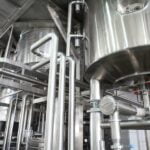The steel industry stands as a formidable force in the global economy, with its influence reaching far and wide. From skyscrapers that touch the skies to the intricate machinery humming in factories, steel forms the backbone of modern civilization. In this article, we delve into the depths of the steel industry, uncovering the challenges it faces, the innovations driving its growth, and the potential solutions that could shape its future. Join us on this journey as we unravel the captivating world of steel and gain insights into an industry that binds nations together.

Steel Industry
The steel industry, often referred to as the backbone of economic progress, plays a vital role in various sectors, including infrastructure, machinery, and transportation. As an alloy of iron and carbon, steel possesses exceptional strength and fracture resistance, making it a preferred choice for construction, manufacturing, and weapon production. However, the steel industry faces several challenges and requires constant innovation to overcome them. In this article, we will explore the challenges, innovations, and potential solutions within the steel industry.
Challenges Faced by the Steel Industry
Over the years, the steel industry has encountered significant hurdles that have impacted its growth and sustainability. One of the primary challenges is the decreasing number of steelworkers. Since the 1980s, the US has witnessed a substantial decline in the number of steelworkers, dropping from 500,000 to 224,000 in 2000[^3^]. This decline in the workforce has posed challenges in meeting the demands of an evolving global economy.
Another challenge lies in the environmental impact of steel production. Despite being one of the largest manufacturing industries globally, the steel industry is known to contribute significantly to greenhouse gas emissions[^8^]. This poses difficulties in achieving sustainable practices and maintaining ecological balance.
Innovations in the Steel Industry
To address the challenges faced by the steel industry, innovative solutions have emerged, revolutionizing its operations. One noteworthy innovation is the use of advanced production methods. Over the centuries, steel production has evolved, with advancements such as blast furnaces, crucible steel, and the Bessemer process[^7^]. These innovations have significantly improved efficiency and increased production capabilities.
Moreover, the steel industry has embraced technological advancements to enhance its sustainability. One such innovation is the adoption of recycling practices. Steel is one of the most-recycled materials globally, with a recycling rate of over 60%[^4^]. This not only reduces waste but also lowers the reliance on virgin raw materials, making steel production more environmentally friendly.
Solutions for a Sustainable Steel Industry
To ensure the sustainable future of the steel industry, various solutions have been proposed and implemented. One crucial aspect is reducing greenhouse gas emissions. Steel manufacturers have been investing in cleaner technologies, aiming to minimize their carbon footprint[^8^]. Efficient energy management, along with the use of renewable energy sources, can help achieve this goal.
Furthermore, the steel industry can explore alternative materials and techniques to reduce dependency on traditional steel production methods. For instance, powder metal forming has gained attention for creating high-carbon steels and other alloy materials[^13^]. These alternatives provide new opportunities for innovation and can improve the industry’s resource efficiency.
Key Takeaways
- The steel industry is a vital pillar of economic progress, contributing to various sectors, including infrastructure, machinery, and transportation.
- Challenges faced by the steel industry include a declining workforce and its environmental impact.
- Innovations such as advanced production methods and recycling practices have revolutionized the steel industry.
- Solutions for a sustainable steel industry include reducing greenhouse gas emissions and exploring alternative materials and techniques.
In conclusion, the steel industry is a complex and evolving sector with its fair share of challenges and innovations. By recognizing and addressing these challenges and embracing innovative solutions, the steel industry can achieve sustainable growth and become a driving force in the global economy.
Quote: “Innovations in production methods and recycling practices have transformed the steel industry, setting the stage for a more sustainable and efficient future.”
Steel is an incredible material that has revolutionized countless industries and has countless fascinating facts associated with it. If you’re curious to learn more about the remarkable qualities of steel, click here for some captivating and enlightening facts about steel: facts about steel. Prepare to be amazed by the versatility, durability, and strength of this extraordinary metal.
Steel Industry
The steel industry plays a crucial role in the world economy, contributing to everything from cars and buildings to infrastructure and appliances. Its impact is far-reaching, with countless industries relying on steel as a fundamental material. If you’re interested in learning more about the steel industry and its various applications, click here to explore a comprehensive guide that covers everything you need to know: Steel Industry Guide.
Throughout history, steel has proven its resilience and strength, making it an essential component in countless structures that stand the test of time. From awe-inspiring skyscrapers to iconic bridges, steel has allowed architects and engineers to push the boundaries of what’s possible in construction. To delve deeper into the fascinating world of steel in architecture, click here: Steel in Architecture.
In addition to its role in construction, the steel industry also finds its way into the automotive sector. The use of high-strength steel in vehicles contributes to enhanced safety and fuel efficiency. If you want to learn more about the vital role of steel in the automotive industry, click here: Steel in Automotive.
The steel industry’s impact on sustainability and the environment is another topic worth exploring. Steel producers are continually developing innovative solutions to minimize their carbon footprint and reduce energy consumption. To discover more about the sustainable practices and initiatives within the steel industry, click here: Sustainable Steel.
As you can see, the steel industry is a multifaceted realm with numerous fascinating aspects. Whether you’re a business professional, a student, or simply curious about the versatile properties of steel, there is something to captivate everyone. Start your journey into the world of steel by clicking on the links above and uncovering the intricate wonders that lie beneath the surface.
Steel Production: How It Works and the Challenges Involved
[youtube v=”xJIlSJ-2qEM”]
Steel production plays a pivotal role in numerous sectors such as infrastructure, machinery, and transportation. It is a crucial material required for reinforcing our nation. To meet the demand, the steel industry produces nearly 200,000 tons of steel every day, which is more than enough to rebuild the Golden Gate Bridge twice over.
One significant aspect of steel production is recycling. In fact, steel is the most recycled material on the planet, surpassing aluminum, copper, paper, glass, and plastic combined. With the current development boom sweeping the nation, Gerdau Steel in Midlothian, Texas, is at the forefront of recycling to keep up with the demand. However, transforming America’s scrap steel into brand new billets comes with its own set of challenges.
One of the major challenges in the steel recycling process is dealing with impurities. Inspector Mark Bell at Gerdau Steel carries out a daily search for impurities, particularly combustible ones. This includes ensuring that cars coming in for recycling have been emptied of any remaining fuel, as metal-on-metal contact during the shredding process can cause sparks and potentially lead to explosions. Mark is skilled at removing the remaining fuel to ensure the safety of the shredding process.
Jams in the shredder are another challenge faced by Gerdau Steel. These jams occur due to the extensive system of belts, wheels, and pulleys used to shred and sort recyclable steel. While jams are inevitable, the focus is on getting the system back on track as quickly as possible. The shredded material is then picked up by magnetic towers that may miss some materials, which is where Mark’s assistance comes in. He ensures that any leftover material is directed towards the shredder using a chute.
Once the scrap steel is shredded, it is taken to the melt shop where it undergoes further processing. At this stage, operator Jeff Rose is responsible for overseeing the arcing process. Graphite rods are lowered into the scrap and subjected to extreme heat, equivalent to one half the heat of the sun. The arcing process melts the scrap steel down, preparing it for the next stage of production.
Carbon content is a critical factor in steel production, as it determines the strength and durability of the steel. Jeff uses a probe known as a catfish pole to measure the carbon content. It is essential to achieve the desired carbon range for the specific grade of steel being produced. Adjustment is necessary if there is too much or too little carbon present to ensure the quality of the final product.
As with any large-scale operation, equipment maintenance is crucial. Cranes are essential for the steel production process, transporting materials to and from various stages. Therefore, when a crane is out of order, it can significantly impact production. Crane mechanic Brian Buckley is responsible for troubleshooting and fixing any issues. His expertise ensures that operations can continue smoothly.
Overall, steel production is an intricate process that requires careful attention to detail. From removing impurities and preventing explosions to precise testing and equipment maintenance, every step is crucial in ensuring the production of high-quality steel.
“Steel production is an intricate process that requires careful attention to detail and the expertise of professionals like Inspector Mark Bell and crane mechanic Brian Buckley. From removing impurities to ensuring the correct carbon content, every step contributes to the production of high-quality steel.”
FAQ
Question 1: What is the significance of the steel industry in the global economy?
Answer 1: The steel industry plays a vital role in the global economy as it is considered an indicator of economic progress. It contributes to infrastructural and overall economic development, making it an essential sector for countries worldwide.
Question 2: How has the number of steelworkers in the US changed over the years?
Answer 2: The number of steelworkers in the US has significantly decreased from 500,000 in 1980 to 224,000 in 2000, reflecting changes in the industry’s labor landscape.
Question 3: What is the recycling rate of steel globally?
Answer 3: Steel is one of the most-recycled materials globally, with a recycling rate of over 60%. This high recycling rate contributes to sustainability efforts and reduces the industry’s environmental impact.
Question 4: What are the main applications of steel in various industries?
Answer 4: Steel is used in various industries, including buildings, infrastructure, tools, ships, trains, cars, bicycles, machines, electrical appliances, furniture, and weapons. Its versatility and strength make it an essential material in countless applications.
Question 5: What are the environmental implications of the modern steel industry?
Answer 5: While the modern steel industry is one of the largest manufacturing industries globally, it also significantly contributes to greenhouse gas emissions. Addressing these environmental implications is crucial for sustainable steel production and a greener future.
















